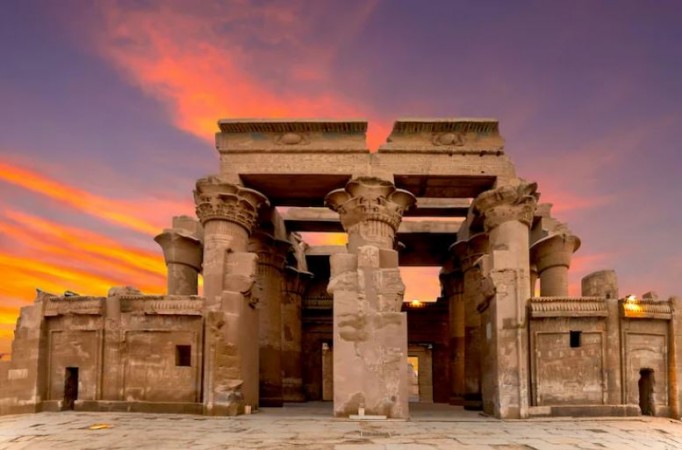
Kom Ombo Temple, also known as the Temple of Kom Ombo, is a unique and captivating historical site located in Upper Egypt. Situated on the east bank of the Nile River, approximately 50 kilometers north of Aswan, this ancient temple stands as a testament to the ingenuity and craftsmanship of the ancient Egyptians. Its remarkable duality, dedicated to two different deities, Sobek and Horus, sets it apart from other temples of its time. With a rich history dating back over 2,000 years, the Kom Ombo Temple remains an important archaeological and cultural treasure, offering valuable insights into the religious beliefs and practices of the ancient civilization.
Also Read: Volcano Manor Beckons: Unleash the Explorer Within You
The construction of Kom Ombo Temple began during the Ptolemaic period, around 180-47 BCE, but its origins can be traced back to the New Kingdom era, making it one of the oldest temples in Egypt. The temple was built on the ruins of an older structure, showcasing the strategic importance of the site in religious and cultural contexts over the centuries.:
What sets the Kom Ombo Temple apart from others is its unique double design. Unlike most temples dedicated to a single deity, Kom Ombo is dedicated to two major gods, Sobek, the crocodile-headed god representing fertility and protection, and Horus, the falcon-headed god symbolizing kingship and sky. The temple is divided into two symmetrical sections, each featuring its own set of sanctuaries, halls, and courtyards. This duality reflects the fusion of two local cults into one harmonious place of worship.
Also Read: Suez, Egypt: Suez is a Seaport City
Kom Ombo Temple is a mesmerizing blend of ancient Egyptian architectural styles, boasting intricate carvings, stunning reliefs, and well-preserved columns. The layout of the temple follows the traditional design, including the main entrance, the first court, a hypostyle hall, the inner sanctuary, and secondary chambers. The outer walls are adorned with hieroglyphics and depictions of rituals, offering an invaluable glimpse into the religious practices of the time.
One of the most intriguing features of the temple is its unique association with medicine. The reliefs found on the walls depict various surgical instruments and medical procedures, suggesting that the temple might have served as a center for medical training and treatment. Sobek, the crocodile god, was believed to have healing powers, and visitors often sought his divine intervention for medical ailments.
Also Read: Embracing Freedom: Unraveling the World of Digital Nomadism
Sobek, the crocodile god, was revered for his protective qualities, especially against the dangers of the Nile River, where crocodiles posed a real threat to the ancient Egyptians. He was also linked to fertility, symbolizing the annual flooding of the Nile that brought life-giving water and nourishment to the land. Horus, on the other hand, was associated with the divine kingship of pharaohs and was believed to be the protector of the ruling monarch. The dual dedication of the temple to these two deities reflects the region's agricultural and economic reliance on the Nile and the divine nature of kingship in ancient Egyptian society.
With the decline of ancient Egyptian civilization, the significance of the Kom Ombo Temple waned. The rise of Christianity in the region led to the neglect and partial destruction of the temple. However, it was not entirely forgotten, as some parts were repurposed as a Coptic church during the Byzantine period.
The rediscovery of the temple in modern times can be attributed to the works of French and British archaeologists during the 19th and 20th centuries. These efforts aimed to preserve the remaining structure and bring attention to the historical importance of this remarkable site.
Also Read: Warsaw: The Resilient Heart of Poland
The Kom Ombo Temple stands as an awe-inspiring testament to the advanced architectural and religious practices of ancient Egypt. Its unique duality, dedication to Sobek and Horus, sets it apart as a fascinating historical marvel. Visitors and archaeologists continue to be enchanted by its well-preserved columns, reliefs, and hieroglyphics, providing invaluable insights into the culture, beliefs, and medical practices of the ancient Egyptians. As one of Egypt's oldest temples, Kom Ombo remains a significant and captivating destination, inviting travelers from around the world to witness the splendor of an ancient civilization that once thrived on the banks of the mighty Nile River.
Also Read: Guru Nanak Darbar Dubai: Embodying Sikhism's Universal Message in the Heart of the Desert
Discover the Enchanting Beauty of Mont Saint-Michel: A Historic Marvel on the Normandy Coast
Madrid - A Vibrant Tapestry of Culture, History, and Modernity